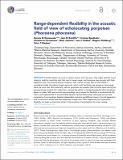Files in this item
Range-dependent flexibility in the acoustic field of view of echolocating porpoises (Phocoena phocoena)
Item metadata
| dc.contributor.author | Wisniewska, D.M. | |
| dc.contributor.author | Ratcliffe, J.M. | |
| dc.contributor.author | Beedholm, K. | |
| dc.contributor.author | Christensen, C.B. | |
| dc.contributor.author | Johnson, Mark | |
| dc.contributor.author | Koblitz, J.C. | |
| dc.contributor.author | Wahlberg, M. | |
| dc.contributor.author | Madsen, P.T. | |
| dc.date.accessioned | 2015-05-15T14:01:04Z | |
| dc.date.available | 2015-05-15T14:01:04Z | |
| dc.date.issued | 2015-03-20 | |
| dc.identifier | 180134416 | |
| dc.identifier | 7c5181aa-f6a0-4302-826f-c75bdd0db905 | |
| dc.identifier | 84925389234 | |
| dc.identifier | 000351866300003 | |
| dc.identifier.citation | Wisniewska , D M , Ratcliffe , J M , Beedholm , K , Christensen , C B , Johnson , M , Koblitz , J C , Wahlberg , M & Madsen , P T 2015 , ' Range-dependent flexibility in the acoustic field of view of echolocating porpoises ( Phocoena phocoena ) ' , eLife , vol. 4 , e05651 . https://doi.org/10.7554/eLife.05651 | en |
| dc.identifier.issn | 2050-084X | |
| dc.identifier.uri | https://hdl.handle.net/10023/6646 | |
| dc.description | Funding: Det Frie Forskningsrad (MJ) | en |
| dc.description.abstract | Toothed whales use sonar to detect, locate, and track prey. They adjust emitted sound intensity, auditory sensitivity and click rate to target range, and terminate prey pursuits with high-repetition-rate, low-intensity buzzes. However, their narrow acoustic field of view (FOV) is considered stable throughout target approach, which could facilitate prey escape at close-range. Here we show that, like some bats, harbour porpoises can broaden their biosonar beam during the terminal phase of attack but, unlike bats, maintain the ability to change beamwidth within this phase. Based on video, MRI, and acoustic-tag recordings, we propose this flexibility is modulated by the melon and implemented to accommodate dynamic spatial relationships with prey and acoustic complexity of surroundings. Despite independent evolution and different means of sound generation and transmission, whales and bats adaptively change their FOV, suggesting that beamwidth flexibility has been an important driver in the evolution of echolocation for prey tracking. | |
| dc.format.extent | 29 | |
| dc.format.extent | 3219249 | |
| dc.language.iso | eng | |
| dc.relation.ispartof | eLife | en |
| dc.subject | Biosonar | en |
| dc.subject | Beam | en |
| dc.subject | Directionality | en |
| dc.subject | Buzz | en |
| dc.subject | Prey capture | en |
| dc.subject | Convergent evolution | en |
| dc.subject | QH301 Biology | en |
| dc.subject | QL Zoology | en |
| dc.subject | DAS | en |
| dc.subject.lcc | QH301 | en |
| dc.subject.lcc | QL | en |
| dc.title | Range-dependent flexibility in the acoustic field of view of echolocating porpoises (Phocoena phocoena) | en |
| dc.type | Journal article | en |
| dc.contributor.sponsor | European Commission | en |
| dc.contributor.institution | University of St Andrews. School of Biology | en |
| dc.contributor.institution | University of St Andrews. Marine Alliance for Science & Technology Scotland | en |
| dc.contributor.institution | University of St Andrews. Sea Mammal Research Unit | en |
| dc.contributor.institution | University of St Andrews. Sound Tags Group | en |
| dc.contributor.institution | University of St Andrews. Bioacoustics group | en |
| dc.contributor.institution | University of St Andrews. Scottish Oceans Institute | en |
| dc.identifier.doi | 10.7554/eLife.05651 | |
| dc.description.status | Peer reviewed | en |
| dc.identifier.grantnumber | PCIG10-GA-2011-304132 | en |
This item appears in the following Collection(s)
Items in the St Andrews Research Repository are protected by copyright, with all rights reserved, unless otherwise indicated.

